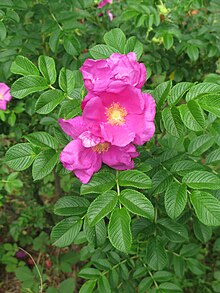Rosa rugosa
| Rosa rugosa | |
|---|---|
 |
|
| Rosa rugosa flower | |
| Scientific classification | |
| Kingdom: | Plantae |
| (unranked): | Angiosperms |
| (unranked): | Eudicots |
| (unranked): | Rosids |
| Order: | Rosales |
| Family: | Rosaceae |
| Genus: | Rosa |
| Species: | R. rugosa |
| Binomial name | |
|
Rosa rugosa Thunb. |
|
Rosa rugosa (rugosa rose, beach rose, Japanese rose, or Ramanas rose) is a species of rose native to eastern Asia, in northeastern China, Japan, Korea and southeastern Siberia, where it grows on the coast, often on sand dunes. It should not be confused with Rosa multiflora, which is also known as "Japanese rose". The Latin word "rugosa" means "wrinkled."
Rosa rugosa is a suckering shrub which develops new plants from the roots and forms dense thickets 1–1.50 m tall with stems densely covered in numerous short, straight prickles 3–10 mm long. The leaves are 8–15 cm long, pinnate with 5–9 leaflets, most often 7, each leaflet 3–4 cm long, with a distinctly corrugated (rugose, hence the species' name) surface. The flowers are pleasantly scented, dark pink to white (on R. rugosa f. alba (Ware) Rehder), 6–9 cm across, with somewhat wrinkled petals; flowering occurs in spring.
The hips are large, 2–3 cm diameter, and often shorter than their diameter, not elongated; in late summer and early autumn the plants often bear fruit and flowers at the same time. The leaves typically turn bright yellow before falling in autumn.
Rosa rugosa is widely used as an ornamental plant. It has been introduced to numerous areas of Europe and North America. It has many common names, several of which refer to the fruit's resemblance to a tomato, including beach tomato or sea tomato; others include saltspray rose, beach rose, potato rose and Turkestan rose. Its fruit are sometimes mistaken for those of the beach plum – despite being entirely different in size, shape, color, texture and taste.
...
Wikipedia
